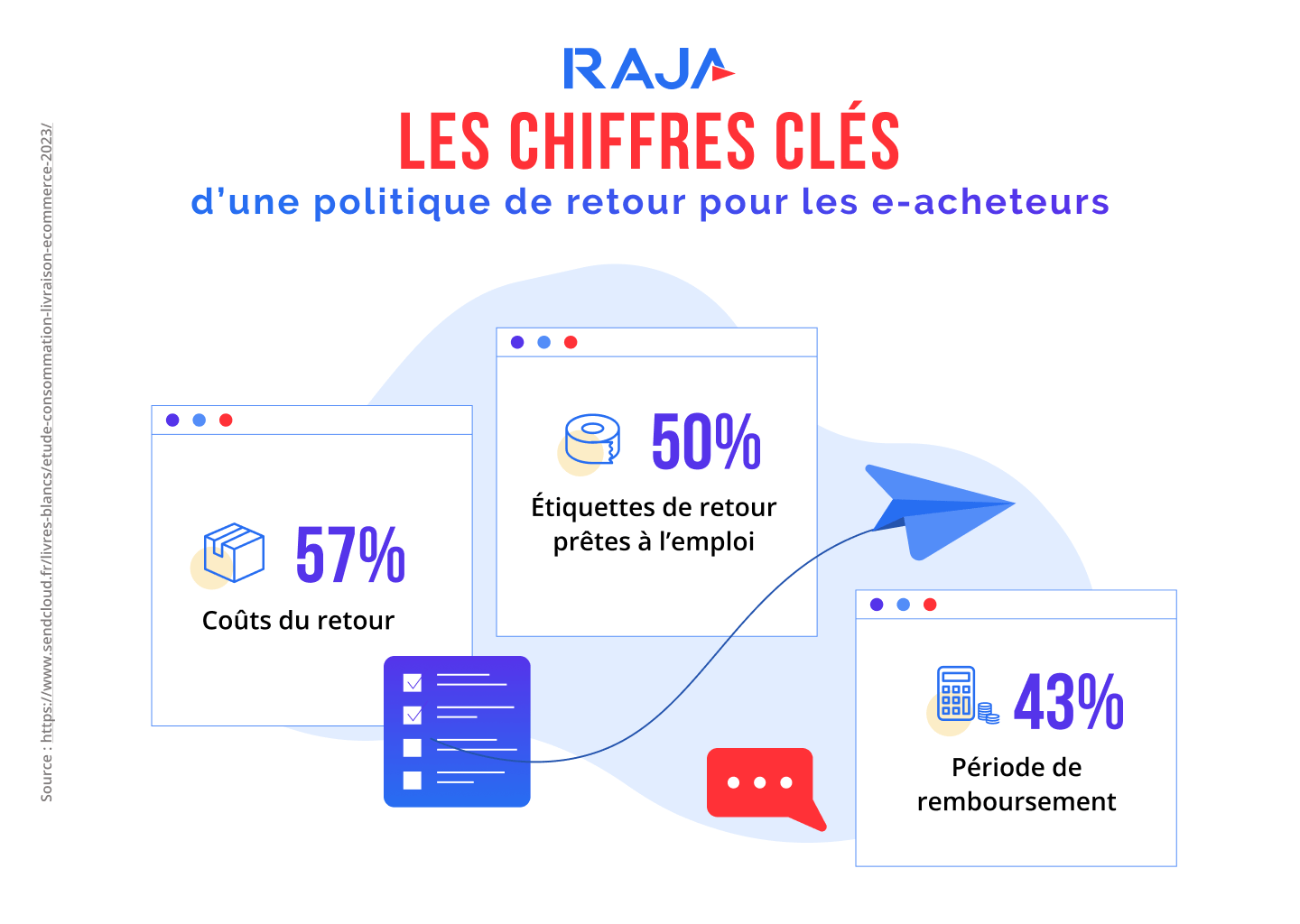Returns are a major issue for e-tailers. According to a recent study, they are a key element in customer satisfaction. 46% of consumers always examine the returns policy before making a purchase. For sellers, offering a bad experience is synonymous with a low conversion rate. A Forbes survey shows that 89% of French people say they face obstacles when it comes to returning their parcels. Faced with this situation, action is urgently needed.
Key figures on returns in e-commerce
Forbes also shows that in France, as in Europe, logistics is becoming one of the key sectors of the economy. For their part, e-retailers need to become more efficient across their entire value chain. From purchase to return, they need tooffer a seamless customer experience.
E-commerce: a fast-growing market in both Europe and France
In 2021, Fevad reports that European e-commerce grew by 13%. The market reached €718 billion. In France, the results for 2022 are positive. Over the course of the year, the French spent almost 147 billion euros on the Internet, an increase of 13.8% over one year. According to Fevad, 2.3 billion online transactions were recorded, with an average basket value of around €65.
Order return rates by European country
Statista and lsa-conso give us more information on the proportion of shoppers who have returned a product ordered online:
- In Germany: 51% ;
- In Switzerland: 51% ;
- Spain: 42%;
- Italy: 39%;
- France: 39%.
Generation Y/Z make more use of returns (15%) than senior citizens (2%). When it comes to returning products, 62% of the French are in favour of relay points, ahead of forwarding by post, collection and in-store returns.
Product returns: a significant environmental impact
In e-commerce, the transport of goods is multimodal. Products make an initial journey from their place of manufacture to the storage warehouse. During this journey, they may be transported by plane, boat or lorry. The final leg of the journey, to the final buyers, is usually by road.
When the products are returned, they make a second journey. This is often similar in nature and duration to the first journey. However, it may be longer. This is the case if the seller decides to send the returned products to a third-party platform. There they are checked before being returned to the original warehouse. Greenhouse gas emissions linked to transport are then doubled.
Worth knowing The environmental impact of a return shipment
According toestimates by The Good Goods, a product ordered online and returned can have an environmental impact up to 2.3 times greater than a non-returned item.
What are the main levers for improving product returns?
Here’s an overview of the solutions that e-tailers have put in place to better manage customer returns.
A clear and transparent returns policy
For 48% of French people, a simplified returns policy is one of the key criteria when shopping online. To stand out from other e-commerce players, it is essential tobe transparent about costs. Be sure to specify return costs in your returns conditions. Your pricing policy may vary depending on the reason for the return.
Do everything you can tospeed up and facilitate the procedure for returning a product. With this in mind, you can offer your customers ready-to-use returns labels. To reinforce your eco-responsible image, you can also :
- Provide a returns QR code;
- Offer consumers the option of generating a QR Code directly online.
RAJA tip Tip: take the opportunity to ask them to indicate the reason for the return. What’s the point? To improve the quality of your services.
Even if European legislation requires a refund within 14 days, don’t hesitate to shorten this period. A sendcloud study shows that the French are not prepared to wait more than 5.3 days on average, the Germans 5.9 and the Spanish 4.3.
Finally, you should know that extending the return period boosts conversions. 44% of consumers would not place an order if it did not exceed 30 days. This figure drops to 30% for a period of less than 60 days. And still according to Sendcloud, brands such as Zappos allow 365 days to return a parcel. Others, such as Oscaro.com and Crocs, give their customers 90 days to return an item.
Discover, in order of importance, the key elements of a returns policy for e-buyers:
- Cost of returns: 57% ;
- Ready-to-use return labels: 50% ;
- Refund period: 43% ;
- Online returns form: 39% ;
- Return period: 39%;
- Return tracking: 36%.

Intelligent parcel lockers
Connected parcel lockers make it easier to receive and return orders. They are mainly located in shopping centres, railway stations or airports. By centralising a large number of deliveries and collections, they reduce the environmental impact of the “last mile”. By 2024, Statista predicts that the size of this market will exceed one billion US dollars.
The trend towards paid returns
One of the major e-commerce trends for 2023 is that of paid returns. Retailers such as Decathlon are making their customers pay for returns. 25% of consumers say they are prepared to pay to return products.
For brands, the aim is to cover their real costs, but also to slow down the flow of customer returns. 81% of European online shoppers regularly return an item if they are not satisfied.
The result? Shops have been struggling to manage returns for many years. By limiting the number of returns, they hope to reduce their carbon footprint and counteract the negative impact on their ecological efforts.
RAJA, your partner for optimising your returns policy
Asa European specialist in e-commerce product returns, RAJA offers a wide range of solutions for your packaging needs. Our teams will help you to better manage your returns, improve the customer experience and implement eco-responsible alternatives.
Committed to a sustainable approach, the group is ISO 14001 certified. It rewards the environmental policy implemented as part of its activity as well as the management of its site. RAJA is a member of FSC® France, which takes action to preserve forests. The leading packaging distributor is also a partner of PEFC France. In 2022, it was awarded the EcoVadis GOLD label.
Good to know RAJA elected Customer Service of the Year 2023.
This selection recognises French companies that place the quality of customer relations at the heart of their priorities. Our advisers answer 98% of telephone calls within 20 seconds. E-mails are answered within 24 hours in 88% of cases. Finally, all chats are answered by an advisor in less than 30 seconds.
Round-trip packaging
Return packaging is a very practical solution for simplifying the return of goods. Designed to be robust, the boxes, pouches and crates feature :
- An adhesive strip on the outside. This is used by the order picker during dispatch;
- A second adhesive strip, on the inside of the parcel. This is the return tape, for use by the customer;
- Between the two, a tear-off strip. This allows the customer to open the parcel cleanly, without scissors or a knife.
Cardboard boxes and protective cases
To limit the number of returns of damaged parcels, opt for packaging with protection. They allow you to ship your most fragile products in complete safety. Available in several formats, they can be adapted to all objects: books, files, multimedia, CDs, DVDs, etc. For example, the brown slipcase box with recycled foam padding is ideal for shipping a tablet, a camera or a drone.
Padding and protection solutions
To ensure that your goods are transported securely, while preventing breakage, use packing particles made from recycled paper. They effectively cushion products by filling empty spaces. Their advantage? They are made from 100% recycled paper, 170 g/m².
RAJA bubble wrap is also eco-responsible. Made from 100% recycled paper, it wraps easily around goods, whatever their shape. It conveys a positive brand image. Its opacity guarantees complete confidentiality. For its ecological innovation, this product has won theOscar for Packaging 2021.
Do you need to transport food products at room temperature, refrigerated or frozen? RANPAK’s Recycold™ Climaliner 85% recycled thermal insulating dunnage paper offers 10 to 48 h thermal protection. All without increasing transport costs.
3 key points to remember:
- For e-tailers, parcel returns have an economic as well as an environmental cost;
- To optimise your returns policy, it’s essential to focus on transparency and clarity;
- Packaging can help e-tailers simplify the management of their returns, while reducing the number of damaged parcels.














